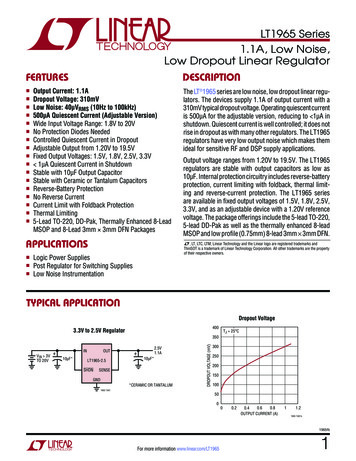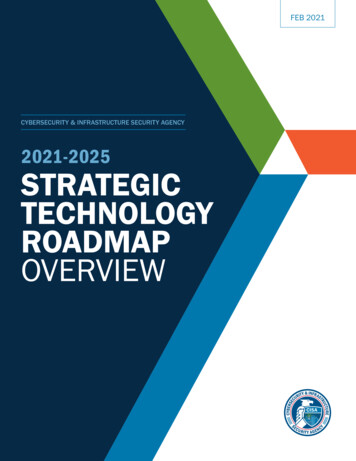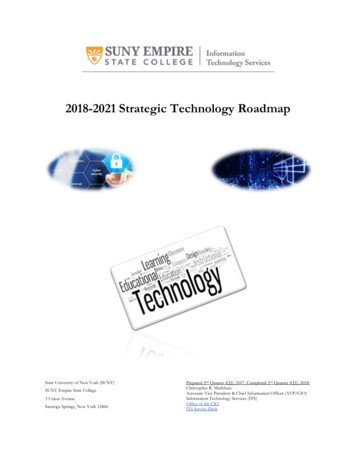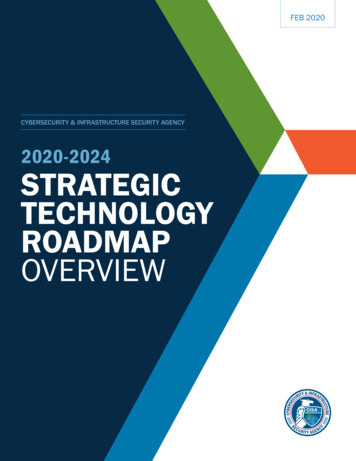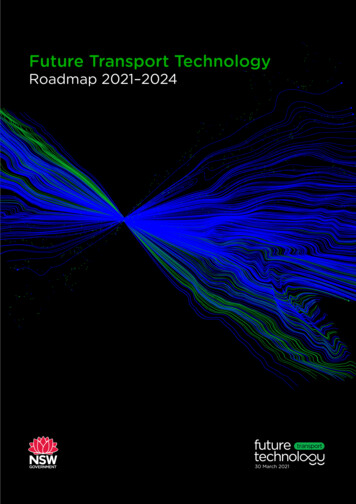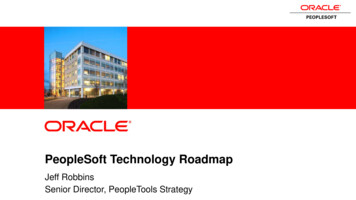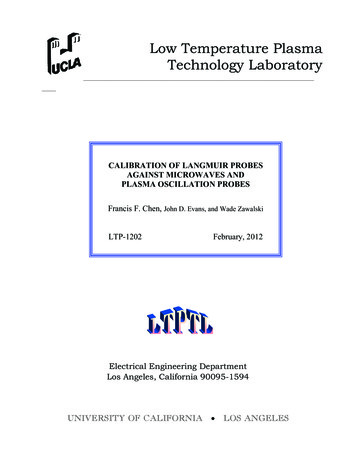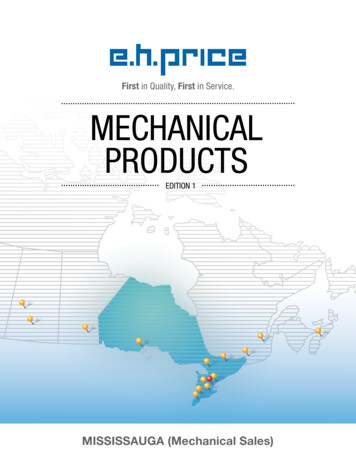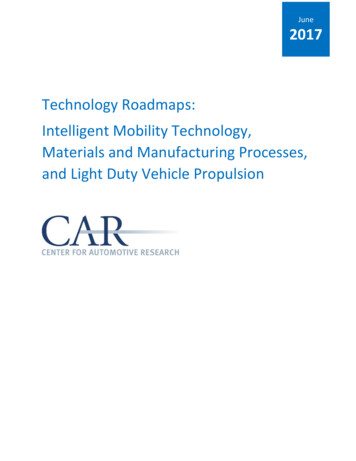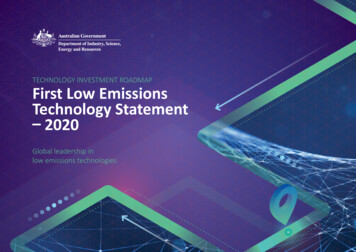
Transcription
TECHNOLOGY INVESTMENT ROADMAPFirst Low EmissionsTechnology Statement– 2020Global leadership inlow emissions technologies
ContentsMinister’s foreword 2Message from the Chair 3At a glance 4Technology Investment Roadmap 8Australia’s big technology challenges and opportunities 13Australia’s priority low emissions technologies 15The Roadmap’s Technology Investment Framework 28Monitoring, transparency and impact evaluation 38Abbreviations and acronyms 40Technology Investment Roadmap: First Low Emissions Technology Statement – 2020 1
Minister’s forewordMinister’s forewordHistory shows that we solve hard problems through enterprise andinnovation. The Newcomen steam engine, the Haber-Bosch process andthe agricultural Green Revolution are all examples of overcoming greatchallenges through technological progress.The global race to reduce emissions will be no exception.That’s why the Government’s emissions reduction strategy is focussedon technology not taxes.Amara’s law dictates that we tend to overestimate the impact oftechnology in the short term, yet underestimate it in the long run. Thatis why the Government will refine its approach over time through futureLow Emissions Technology Statements.The Technology Investment Roadmap is first and foremost a researchand development strategy.These will be tabled in Parliament each year, detailing the impact ofour investments and our progress towards clearly-defined prioritytechnology stretch goals.Existing, proven technologies like coal, gas, solar and wind will playimportant roles in Australia’s energy future, but are not the focus of theRoadmap. The Government will continue to invest in mature technologieswhere there is a clear market failure, like a shortage of dispatchablegeneration, or where these investments secure jobs in key industries.Getting these technologies right will create jobs, and preserve andexpand our energy-intensive export industries. We will beat our 2030emissions reduction target, with a platform for future emissionsreductions beyond the next decade.But the Roadmap recognises that widespread deployment is primarilydriven by the private sector, with a targeted role for public investment.The Government’s efforts will focus on new and emerging technologieswith the potential for transformational economic and emissionsoutcomes, in Australia and globally.We will enact change by:1. Accelerating technology development through an investment andincentives framework that spans from research and developmentto pre-commercial deployment2. Enabling our agencies to invest in the next generation oftechnologies through a legislative and regulatory reform package3. Working together with our trading partners, because deliveringglobal outcomes requires international collaboration.This technology-led approach won’t compromise energy affordability orreliability, and will position Australia as a global technology leader.I express my sincere appreciation to Australia’s Chief Scientist, Dr AlanFinkel, and the other members of the Ministerial Reference Panel: AlisonWatkins, Ben Wilson, Drew Clarke, Grant King, Shemara Wikramanayakeand Jo Evans. This Statement benefitted greatly from their expert adviceand insight.The Hon Angus Taylor MPMinister for Energy and Emissions ReductionTechnology Investment Roadmap: First Low Emissions Technology Statement – 2020 2
Message from the ChairMessage from the ChairThe Technology Investment Roadmap addresses the biggest globalchallenge of our era – to rapidly reduce emissions in a way thatsupports economic growth.Technology is key to achieving this ambition. The Low EmissionsTechnology Statement is the first major milestone in the Roadmap.It identifies how emerging low emissions technologies can becomeeconomically competitive with and replace high emission incumbents,just as electric light bulbs replaced kerosene lamps, and are now beingreplaced by LEDs.For the Roadmap, I am confident that the combination of Australianingenuity and clearly articulated Government support will see thesetechnologies rapidly become competitive.I’ve been fortunate in recent years to contribute to the building blocksthat are supporting an orderly transition to a low emissions future.In 2017, the review of the National Electricity Market set in motionimportant reforms that continue to be implemented through the workof the National Cabinet Energy Reform Committee. In 2019, the adoptionof the National Hydrogen Strategy by all Australian governmentsstimulated domestic and international investor interest in the use ofclean hydrogen as a chemical feedstock, for energy storage and forexporting renewable energy. And now, in 2020, the Low EmissionsTechnology Statement identifies the next steps required to acceleratethe economically effective adoption of priority and enablingtechnologies through a principles-based investment framework.I offer my sincere thanks to Minister Taylor for his engagement, insightand forward thinking, which gave direction to this project from start tofinish, and I commend his key role in the development of the NationalHydrogen Strategy last year. The Panel members Alison Watkins, BenWilson, Drew Clarke, Grant King, Jo Evans and Shemara Wikramanayakeall have broad industry, policy and energy markets expertise thathas enabled them to consider the technology challenges from theperspectives of industry, investment and shared benefits across thecommunity. I thank them deeply for their wise counsel throughout.I thank the leadership of the Department of Industry, Science, Energyand Resources for their guidance and support, and I extend my warmappreciation to the masterful taskforce that did all the hard work.Finally, it is my pleasure to note the broad engagement from thepublic during the consultation process. The workshops and the writtensubmissions helped us greatly in formulating our advice to the Minister.Dr Alan Finkel AOAustralia’s Chief ScientistChair, Ministerial Reference PanelTechnology Investment Roadmap: First Low Emissions Technology Statement – 2020 3
At a glanceAt a glanceOur visionA prosperous Australia, recognised as a globallow emissions technology leader.Strategic intentsAccelerate the development of new and emerging technologies bymaking them economically competitive with established technologies,unlocking new opportunities across the country.Build on our existing role as a trusted exporter of energy, resourcesand agricultural products, and secure continued prosperity in a lowemissions global economy.Realise our vision through a lasting partnership between industry,investors, researchers, governments and the broader community to:npreserve and create jobs, capture new opportunities and revitaliseAustralia’s regional economiesnlower household living expenses with abundant, clean andlow-cost energynbuild competitiveness by leveraging our comparative advantagesnattract and retain the best minds in priority low emissions technologyresearch fields.Technology Investment Roadmap: First Low Emissions Technology Statement – 2020 4
At a glanceOUR VISIONA PROSPEROUS AUSTRALIA, RECOGNISED AS A GLOBALLOW EMISSIONS TECHNOLOGY LEADERTHE BIG TECHNOLOGY CHALLENGESDelivery of more affordable,clean and reliable energyto households and industryfor transportation, heating,production and powerExpanding productionand increasing productivity,creating jobs and substantiallyreducing emissions fromAustralia’s primary industriesGOVERNMENT INVESTMENTPreserving and expandingonshore manufacturing ofenergy-intensive products andcapturing new export marketsfor low emissions commoditiesScaling geological andbiological sequestrationto provide globallysignificant permanentsequestration of CO₂PRIVATE INVESTMENTTechnology Investment Roadmap: First Low Emissions Technology Statement – 2020 5
At a glanceHighlightsPRIORITYTECHNOLOGYSTRETCH GOALSANTICIPATED IMPACTSFROM THE PRIORITIESPUBLIC–PRIVATEPARTNERSHIPCLEAN HYDROGENOVERACHIEVEunder 2 per kilogramon our Paris Agreement commitments, with a pathwayto deeper emissions reductions beyond 2030AIM TO CATALYSE 3– 5 OF NEW INVESTMENTFOR EACH DOLLAR OF COMMONWEALTH FUNDINGENERGY STORAGEelectricity from storage forfirming under 100 per MWh*LOW CARBON MATERIALSlow emissions steel productionunder 900 per tonne and lowemissions aluminium under 2,700 per tonneCCS – CO₂ COMPRESSION,HUB TRANSPORT ANDSTORAGEunder 20 per tonne of CO₂SOIL CARBONmeasurement under 3 per hectare per year* This would enable firmed wind andsolar at pricing at or below today'saverage wholesale electricity priceSUPPORT OVER 130,000 JOBS BY 2030with more than half in regional communitiesto achieve 50 to 100 billion in new investment domesticallyover the decade to 2030A TECHNOLOGY INVESTMENT FRAMEWORKin our energy-intensive manufacturing sectorsto improve coordination of delivery agencies – ARENA, the CEFCand CER – towards national technology priorities and expectedGovernment investment of 18 billion in low emissionstechnologies over the decade to 2030AVOID IN THE ORDER OF 250 MILLION TONNESOF EMISSIONS PER YEAR BY 2040RETAIN ARENA ON THE FRONTLINE OF DIRECTGOVERNMENT INVESTMENTPRESERVE AND EXPAND EMPLOYMENTthrough deployment of priority technologies at homeand Australia's low emissions exportsin low emissions technologies, playing a central role indelivering Roadmap priorities. New funding for the CEFCto support grid reliabilitySIGNIFICANTLY REDUCE GLOBAL EMISSIONSARENA WORKING WITH THE CEFCAND OTHER AGENCIESfrom energy, transport, industry and agriculture ifpriority technologies achieve widespread deployment.These sectors account for around 90% of emissions andemit approximately 45 billion tonnes of CO₂ each year.to develop a goal-oriented program for priority low emissionstechnologies like low emissions steel, low emissions aluminium,and energy storageESTABLISH AUSTRALIA’S FIRST REGIONALHYDROGEN HUBco-locating domestic hydrogen users with an export focusto create global hydrogen supply chain linkagesSCALE CCSto support emissions reduction from power generation,oil and gas extraction, natural gas processing, industry orhydrogen productionTechnology Investment Roadmap: First Low Emissions Technology Statement – 2020 6
At a glanceGovernment action towards our visionInvestment andincentives frameworkLegislative andregulatory reformsInstitutions andgovernanceMonitoring, transparencyand impact evaluationStretch goals are a clear signal tothe private sector on where theGovernment will focus its efforts.Additional flexibility for ARENAand the CEFC will enable them toinvest in the next generation ofenergy technologies and supportemissions reductions across allsectors of the economy.A permanent TechnologyInvestment Advisory Council– including ARENA, the CEFCand CER – will advise on thepreparation of future LowEmissions Technology Statements.Future Low Emissions TechnologyStatements will report on progresstowards priority technologystretch goals.Actions to strengthen theenabling environment and removeregulatory barriers.These Statements will be tabled inParliament.The Government’s investment andincentives framework spans fromresearch and development topre-commercial deployment: fromARENA to CEFC and through tothe Emissions Reduction Fund.Government will enter intointernational partnershipsto collaborate on prioritytechnologies.Commonwealth-State deals willleverage greater co-investmenttowards Low EmissionsTechnology Statement priorities.Government’s approach toregulation will respect consumerchoice and trust householdsand businesses to adopt newtechnologies as they approachparity.ARENA and the CEFC’s investmentmandates will be updated toreflect the Statement priorities.Impact evaluation will besupported by regular reportingfrom key agencies.Investment, regulatory andlegislative frameworks will bereviewed annually to ensuretheir alignment with prioritytechnologies.Technology Investment Roadmap: First Low Emissions Technology Statement – 2020 7
Technology Investment RoadmapTechnologyInvestment RoadmapAustralia’s Technology Investment Roadmap(the ‘Roadmap’) is an enduring strategy toaccelerate the development and commercialisationof new and emerging low emissions technologies.Key milestones of the Roadmap process are annual Low EmissionsTechnology Statements (the ‘Statement‘) that will prioritise lowemissions technologies with the potential to deliver the strongesteconomic and emissions reduction outcomes for Australia.As we recover from COVID-19, the Roadmap will prioritiseinvestments in new and emerging technologies that support jobsand economic recovery.In May 2020, the Minister for Energy and Emissions Reductionpublished a discussion paper outlining the key stages of theRoadmap and commencing a survey of new and emergingtechnologies (Figure 1).1Technology Investment Roadmap: First Low Emissions Technology Statement – 2020 8
Technology Investment RoadmapFigure 1: The Technology Investment RoadmapStage one: Settinga clear visionContinue throughannual Low EmissionsTechnology StatementsStage two: Surveyingnew and emergingtechnologiesStage eight:Assessing theimpact oftechnologyinvestmentsStage three: UnderstandingAustralia’s technologicalneeds and comparativeadvantagesFocus of this firstLow EmissionsTechnology StatementStage four:IdentifyingprioritytechnologiesStage seven:Balancing theoverall investmentportfolioPrioritisation under four filterssStage six:ImplementinginvestmentsStage five: Identifying the most efficientdeployment pathways and settingeconomic targets for key technologiesTechnology Investment Roadmap: First Low Emissions Technology Statement – 2020 9
Technology Investment RoadmapMinisterial Reference PanelA Ministerial Reference Panel, chaired by Australia’s Chief Scientist, Dr Alan Finkel AO, and comprising industry, private investment, government andresearch leaders was established to advise the Minister in the preparation of the first Low Emissions Technology Statement (Figure 2). Recognisingthe Panel’s ongoing role in s
Technology Investment Roadmap Australia’s Technology Investment Roadmap (the ‘Roadmap’) is an enduring strategy to accelerate the development and commercialisation of new and emerging low emissions technologies. Key milestones of the Roadmap process are annual Low Emissions Technology Statements (the ‘Statement‘) that will prioritise low
